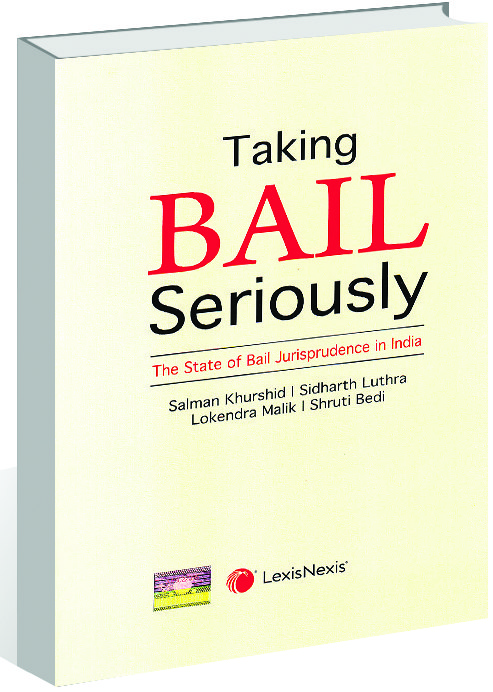Taking Bail Seriously: The State of Bail Jurisprudence in India Edited by Salman Khurshid, Sidharth Luthra, Lokendra Malik, Shruti Bedi. Lexis Nexis. Pages 512. Rs 995.
Book Title: Taking Bail Seriously: The State of Bail Jurisprudence in India
RS Cheema
The approach to the question of grant of bail is ad-hoc, the manner of dealing with the relevant submissions is casual and the final result is the hunch of the judge as rightly noticed by the apex court. The settled principles, which serve as a guideline to achieve a desirable degree of uniformity in the legal response to grant of bail, lose relevance because special penal laws, which we have in abundance, raise specific and additional roadblocks in the grant of bail. Consequently, the lack of uniformity in bail jurisprudence becomes even graver. Further, the declared judicial principle that bail not jail is the rule, though ceaselessly chanted and reiterated, has become an elusive goal. Lastly, there is no reliable data enabling us to weigh as to whether the bail was rightly granted in some cases and declined in others. It is, however, apposite to mention that the personal experience of any participant on either side of the bar would reveal that there is no logical co-relation between the grant and refusal of bail on the one hand and the final outcome of the trial for the offence alleged.
Taking Bail Seriously is a highly valuable addition to the literature in the area of bail jurisprudence in the country. It is a very ambitious project where an attempt has been made to examine and evaluate multiple dimensions of the bail jurisprudence in a single volume. It is an enterprise wherein judges, practising advocates, research scholars and teachers have participated, which makes it a formidable piece of work. There are 22 well-researched articles that deal with nearly all the aspects touching the question of bail. Thus, in a single volume we have the occasion to enrich ourselves from an in-depth analysis of bail jurisprudence in general on one hand and specific issues relating to the question of bail on the other. The authors have also dealt with the treatment of foreign national prisoners in the matter of bail; transit bails and remand; default bail; bail in terror offences and bail in economic offences like PMLA. A short volume could not possibly answer all the questions a reader may ask, yet, the work must be lauded as a handy reference book for anyone confronted with a meaningful question on the subject. It is, thus, indispensable for the advocate, the judge, the academic dealing with criminal jurisprudence and all others interested in the matter.
Before briefly touching upon the contents of the book, the foreword by Justice H.S. Bedi, former judge Supreme Court of India, calls for a special mention. Besides encapsulating the relevance of various questions, Justice Bedi has examined the matter with a remarkable candour and in a truly realistic perspective. He has kept in focus the ‘raw reality’ (an expression insightfully used by Late Justice Krishna Iyer while grappling with the vexing question of bail). Justice Bedi also rightly notices, “The lack of consistency in Bail Jurisprudence is the most vexing question before the lawyers and judges alike.”
While the volume in hand was in advance stage of preparation, the apex court decided the prayer of P. Chidambram, a senior advocate himself and a former finance minister, for pre-arrest bail, against the petitioner in a case under PMLA. The decision generated nationwide controversy. Expectedly, the majority was critical of the judgment as the propositions enunciated therein ran counter to many settled judicial principles.
In the very first article by A.M. Singhvi, there are direct and indirect references to the manner in which the Enforcement Directorate was able to effectively oppose the prayer for bail by relying upon the sealed cover process. Salman Khurshid refers to the case by discreetly calling it the ‘bail matter of a high-profile political leader’. Fortunately, Upendra Baxi has devoted an entire article to various questions emanating from the decision. He has questioned the divorce between Constitution and the statutory law regarding bail as an unwarranted fallout of the decision. The article is a must read for its focus on some basic and critical questions. A mention may be made to an article by Khagesh Gautam and Sebastian Lefrance on a comparative survey of the law of bail in India and Canada. The authors notice that both in Canada and US Constitutions, an express basis has been laid down touching the question of bail.
Justice S.S. Saron in his concise overview of bail jurisprudence has highlighted decisions of the Punjab and Haryana High Court linking the question of bail with prolonged detention at the appellate stage. Shruti Bedi’s own contribution is a brief and incisive evaluation of the judgment of the Apex Court in Nikesh Tarachand Shah vs Union of India. She has effectively raised the question for need of constitutional review of various legislative provisions placing a near embargo on the power of the court to grant bail.
Most contributions embark upon a general review of the bail jurisprudence, hence, there is repetition, quite unavoidable in such a scenario. The title of the book echoes through majority of the essays. The article on default bail by Monica Chaudhary, though exhaustive, confines the debate to default bail made available to an accused upon the failure of the investigating agency to complete the investigation and file the charge sheet within the statutory period permissible under the law. It is time that the principle of default bail is extended to inordinate delays in the conclusion of the trial. The articles shedding light on the plight of the poor in the matter of bail effectively underline the truth that some citizens are more equal than others under our legal system. The law and practice of arrest is an integral part of bail jurisprudence. Similarly, the manner in which orders of remand are passed mechanically also calls for brainstorming analysis. Both these aspects have been scrutinised by the authors.
While the editors and the authors have done a commendable job, the subject is much too vast for all the questions to be raised and answered in one single volume. It is essential to carry out empirical studies of the process of grant of bail in the magisterial court, court of sessions and the high court, which would provide reliable data to meet the flood of pending bail applications in the various HCs and help in evolving a just, fair and equitable bail jurisprudence. It is equally important to empower the public prosecutor to decide appropriate cases where bail ought not to be opposed. It is also desirable that the states formulate guidelines to facilitate the process. After all, the overcrowded jails are a perpetual challenge to the system and ways and means must be found to keep the numbers of prisoners in the jail within manageable limits.
— The writer is former Advocate General, Punjab














